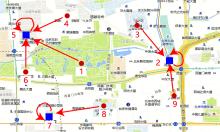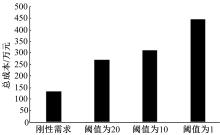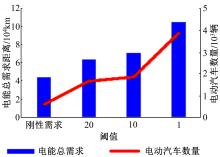Journal of Jilin University(Engineering and Technology Edition) ›› 2019, Vol. 49 ›› Issue (5): 1471-1477.doi: 10.13229/j.cnki.jdxbgxb20181270
Location and capacity model of electric vehicle charging station considering commuting demand
Qing-yu LUO( ),Wan-li TIAN,Hong-fei JIA(
),Wan-li TIAN,Hong-fei JIA( )
)
- College of Transportation, Jilin University, Changchun 130022, China
CLC Number:
- U491
| 1 | DongJ, LinZ. Within-day recharge of plug-in hybrid electric vehicles: energy impact of public charging infrastructure[J]. Transportation Research Part D: Transport and Environment, 2012, 17(5): 405-412. |
| 2 | NieY, GhamamiM, ZockaieA, et al. Optimization of incentive polices for plug-in electric vehicles[J]. Transportation Research Part B: Methodological, 2016, 84: 103-123. |
| 3 | NieY, GhamamiM. A corridor-centric approach to planning electric vehicle charging infrastructure[J]. Transportation Research Part B: Methodological, 2013, 57: 172-190. |
| 4 | HeF, YinY, ZhouJ. Deploying public charging stations for electric vehicles on urban road networks[J]. Transportation Research Part C: Emerging Technologies, 2015, 60: 227-240. |
| 5 | 程宏波, 肖永乐, 王勋, 等. 基于引力模型的电动汽车充电站选址规划[J]. 电工电能新技术, 2016, 35(5): 61-66. |
| ChengHong-bo, XiaoYong-le, WangXun, et al. Site planning of electric vehicles charging station based on gravity model[J]. Advanced Technology of Electrical Engineering & Energy, 2016, 35(5): 61-66. | |
| 6 | HuangY, ZhouY. An optimization framework for workplace charging strategies[J]. Transportation Research Part C: Emerging Technologies, 2015, 52: 144-155. |
| 7 | ZhuZ H, GaoZ Y, ZhengJ F, et al. Charging station location problem of plug-in electric vehicles[J]. Journal of Transport Geography, 2016, 52: 11-22. |
| 8 | YangY, YaoE, YangZ, et al. Modeling the charging and route choice behavior of BEV drivers[J]. Transportation Research Part C: Emerging Technologies, 2016, 65: 190-204. |
| 9 | SunX, YamamotoT, MorikawaT. Charge timing choice behavior of battery electric vehicle users[J]. Transportation Research Part D: Transport and Environment, 2015, 37: 97-107. |
| 10 | DongJ, LiuC, LinZ. Charging infrastructure planning for promoting battery electric vehicles: an activity-based approach using multiday travel data[J]. Transportation Research Part C: Emerging Technologies, 2014, 38: 44-55. |
| 11 | PearreN S, KemptonW, GuenslerR L, et al. Electric vehicles: how much range is required for a day’s driving[J]. Transportation Research Part C: Emerging Technologies, 2011, 19(6): 1171-1184. |
| [1] | CAO Qian, LI Jun, LIU Yu, QU Da-wei. Construction of driving cycle based on Markov chain for passenger car in Changchun City [J]. Journal of Jilin University(Engineering and Technology Edition), 2018, 48(5): 1366-1373. |
| [2] | SUN Bao-feng, GAO Kun, SHEN Xiu-xiu, LIANG Ting. Location model of gas station for network expansion based on capacity balance and variable coverage radius [J]. 吉林大学学报(工学版), 2018, 48(3): 704-711. |
| [3] | XU Liang,CHENG Guo-zhu. Setting minimum vehicle speed limit on freeway based on speed scattering and economic speed [J]. 吉林大学学报(工学版), 2010, 40(03): 661-0665. |
|
||







